Mark Sisson's Blog, page 234
January 27, 2016
Contest Winner: Grokpose for $1,000
 Earlier in the challenge, I asked people to pose like Grok for a chance to win a pretty epic prize. The rules were simple, but the ingenuity and thought put into every submission were far from it. So after much posing, primping, and staging, we have a winner…
Earlier in the challenge, I asked people to pose like Grok for a chance to win a pretty epic prize. The rules were simple, but the ingenuity and thought put into every submission were far from it. So after much posing, primping, and staging, we have a winner…
Congrats to @PaleoFam321X, who was randomly selected from the list of submissions to win $1,000 to spend at PrimalBlueprint.com!
And a big thanks to everyone who sent in a picture. I’ve posted them all below. What do you think, folks? Who hits the most accurate pose? The most creative? The most intense? I’ve got to say, I’m impressed by each and every one of them. Maybe a few of you have future careers as Stone Age models? Eat your offal out, Calvin Klein.
Stay tuned. I’ll be publishing reader-created content all week long. In the meantime, Grok on!
They call me Goodies Against The Grok! #grokinthewild @marksdailyapple
A photo posted by Sadie Radinsky (@goodiesagainstthegrain) on Jan 21, 2016 at 5:55pm PST
Interview with Simon Whitfield: Olympic Gold Medalist
 As many of you know, I have a long history as a former elite endurance athlete. Back in the day, I achieved a 2:18 marathon and landed 4th place in the Hawaii Ironman. That was all well and good, but above all I was vying for Olympic gold. There was just one small issue: I was giving my body the beat down in the process. At the time, guided by traditional training advice, my eye was on the prize, not the long term sacrifices I was making to get there. I couldn’t see the forest for the trees, so to speak. After years of spending time in the endurance game, life had other things in store for me—researching, blogging, and sharing my story with all of you, for example. And I’ve never looked back. But that hasn’t stopped me from respecting the awesome achievements made by my past contemporaries, or the great wisdom they have to share as a result of their boundary breaking feats.
As many of you know, I have a long history as a former elite endurance athlete. Back in the day, I achieved a 2:18 marathon and landed 4th place in the Hawaii Ironman. That was all well and good, but above all I was vying for Olympic gold. There was just one small issue: I was giving my body the beat down in the process. At the time, guided by traditional training advice, my eye was on the prize, not the long term sacrifices I was making to get there. I couldn’t see the forest for the trees, so to speak. After years of spending time in the endurance game, life had other things in store for me—researching, blogging, and sharing my story with all of you, for example. And I’ve never looked back. But that hasn’t stopped me from respecting the awesome achievements made by my past contemporaries, or the great wisdom they have to share as a result of their boundary breaking feats.
That’s why I wanted to point all of you to yesterday’s podcast interview with three people whom I respect very much—folks who know what it’s like to push the boundaries of physical limitations, and walk away with reformed, insightful perspectives as a result. They’re the kinds of athletes that inspired me to write Primal Endurance, so the tradition of competition, sportsmanship, teamwork, and personal betterment can continue, but in a way that maximizes results while protecting one’s body for the long haul. So if you haven’t heard the show yet, here’s what it’s about.

Hosts Brad Kearns and Andrew MacNaughton connect with retired triathlon legend Simon Whitfield from Victoria, B.C., Canada. Simon details his remarkable victory in the inaugural Olympic triathlon in Sydney, Australia in 2000, along with other memories and perspectives he gained from his lengthy career at the top of the sport. Simon is an extremely thoughtful, introspective athlete whose insights can provide great value to whatever peak performance or life goals you pursue. “If you love your pursuits, you’ll find a way to success. If you succumb to your fears and insecurities, your results will suffer accordingly,” says Simon. With refreshing candor, Simon mentions the dangers of drifting into a prima donna perspective and how to recalibrate to focus on the journey; especially having a strong and authentic support team. “Hard truths come with sharp edges, but they are the source of the greatest learning,” Simon offers. Simon updates us about his recent doings, including epic standup paddling adventures in Victoria. Enjoy this deeply revealing and impactful discussion with triathlon’s most thoughtful coach, Andrew MacNaughton, and most thoughtful elite athlete, Simon Whitfield.
Thanks for reading (and listening), everyone. I hope you enjoy the episode!




January 26, 2016
Contest Poll: 2016 Primal Blueprint Recipe Videos
 A couple weeks back I asked you to film and share your favorite Primal Blueprint recipes for a chance to win $1500 in gift certificates to US Wellness Meats. This particular contest has always been a 21-Day Challenge staple, but this year, I upped the ante by moving the contest over to Instagram, thus limiting videos to just 15 seconds each. The response was nothing short of amazing, as you guys came through with 35 top-notch entries!
A couple weeks back I asked you to film and share your favorite Primal Blueprint recipes for a chance to win $1500 in gift certificates to US Wellness Meats. This particular contest has always been a 21-Day Challenge staple, but this year, I upped the ante by moving the contest over to Instagram, thus limiting videos to just 15 seconds each. The response was nothing short of amazing, as you guys came through with 35 top-notch entries!
Picking a short list of favorites was challenging, so the Worker Bees and I threw our favorites into a pot and chose the first five. I’m telling you, all of this year’s submissions were pretty amazing.
While there can only be one winner, I want to give a huge thanks to everyone that took the time to submit a video. I hope you had as much fun making them as we had watching them!
Watch all the videos in the playlist below, then vote for your favorite in the poll at the bottom of the page.
Voting will close and a winner will be announced at 6 pm PST, Wednesday, January 27.
A video posted by Joanna Noel (@joannanoel3051) on Jan 24, 2016 at 6:01pm PST
January 25, 2016
Dear Mark: 21-Day Challenge Rapid Fire Edition, Part 2
 Last week, I answered a bunch of the questions readers asked at the start of the 21-Day Challenge. You guys came up with so many great questions that I couldn’t get through all, or even most of them. So today, I’m back with another round of rapid fire answers to many of your questions. I talk about the utility (or lack thereof) of window-filtered sunlight in the winter, the need (or not) for 8 glasses of water a day, how fasting can impact fitness, why someone’s sleep might be suffering, which source of glycine is best, whether chlorine in a pool is bad for you, and many, many more.
Last week, I answered a bunch of the questions readers asked at the start of the 21-Day Challenge. You guys came up with so many great questions that I couldn’t get through all, or even most of them. So today, I’m back with another round of rapid fire answers to many of your questions. I talk about the utility (or lack thereof) of window-filtered sunlight in the winter, the need (or not) for 8 glasses of water a day, how fasting can impact fitness, why someone’s sleep might be suffering, which source of glycine is best, whether chlorine in a pool is bad for you, and many, many more.
Let’s go:
Living in Canada wondering what the effects are of sun if behind glass?
Sitting at home in the sun or in the car, does a longer exposure behind glass get me anywhere close to the 15 mins of sun?
Window-filtered sunlight can certainly feel good. There’s nothing like curling up by the window with a great book on a cold, but sunny winter day. Just ask cats. They know all about it.
Unfortunately, windows do not allow UVB through, only UVA. And as UVA penetrates deep into the epidermis, which causes aging, while UVB interacts mostly with the top layers of skin and is the wavelength response for vitamin D synthesis, this is a problem. UVB counteracts the UVA damage; UVA keeps the vitamin D synthesis from getting out of hand. You need both. If we upset the balance and get too much UVA without enough UVB, as you would through a window, problems arise.
Now, hanging out by the window on a sunny day won’t give you skin cancer. I’m not suggesting that. However, you won’t be getting all the benefits you normally associate with sun exposure, and you may do damage if you rely on window-filtered sun as a vitamin D source on a regular basis.
Do you subscribe to the “8 glasses of water” or “drink half your body weight in ounces” or do you think its better to focus on high-water-content foods and nutritious drinks like bone broth and kombucha?
No, I’ve long rejected that advice, which has no actual scientific foundation.
High water content foods are almost every food you can imagine.
Well, not every food. The average Westerner eating lots of baked goods, processed junk, fried foods, and other non-Primal, low-water fare may need extra water, but you? Nearly everything on the list of Primal Blueprint-approved foods—meats, seafood, fruit, vegetables, roots, tubers—contain more water than you’d probably think. After all, every organism on earth depends on and is comprised of lots and lots of water. So long as you consume those organisms without removing too much of the water, you’ll be getting plenty of water.
And yeah, liquids like bone broth work great. If you’re training, a pinch of sea salt in water helps.
Water needs do go up with hot weather and exercise. Even then, though, you don’t need to do any calculations to determine your needs. Thirst is the guide. Thirst is an accurate predictor of water needs, even in athletes engaged in physical activity. Thirst literally triggers the part of your brain that determines “physiological need states” and motivates seeking behavior. Thirst is the best barometer we have.
How does intermittent fasting play into Primal fitness, if at all? What are your thoughts on this practice?
Fasting is primarily a healthy aging buffer and occasional tool for fat loss. It’s not really meant to improve fitness.
However, just like “train low(carb), race high(carb)” can help endurance athletes retain glycogen for the final push in races, fasted training can improve glycogen retention during physical activity by training you to burn more fat and fewer carbs. If you’re in a fasted state, you’re burning fat.
One study exemplifies this phenomenon, pitting a group of untrained, carb-fed cyclists against a group of untrained, overnight-fasted cyclists and comparing both groups’ muscle glycogen content and V02 max. The fasted group improved their V02 max by nearly 10% and their glycogen content by over 54%, while the fed group improved V02 max by just 2.5% and glycogen by a paltry 2.9%.
Anecdotally, many people report feeling energized during fasted training. This is something to play with, and if you feel good training in a fasted state, it’s probably doing you good.
Mark, I basically eat primal and get seven to eight hours of sleep a night, along with exercising 5 – 6 days a week. I still have no energy. What can I do to increase my energy levels and feel rested in the morning?
Don’t exercise 5-6 days a week! That’s too much for most people. Lack of energy is a huge tell.
I’ve been trying to make sure I get a little bit of gelatin, collagen, tendon, or bone end caps with every meal. Is one form of glycine any better than the others? Putting some dissolved collagen into my tea is the easiest, but I’ve been mixing it up just in case.
Thanks!
Glycine is glycine is glycine.
What changes is the stuff that comes along with the glycine. So straight-up collagen hydrolysate is just that, while bone end caps and tendons have that plus other bone-related nutrients. You can go even further and get your glycine—and tons of muscle protein, B vitamins, and other nutrients—through gelatinous meats like oxtail or beef shank. They all work, although straight glycine infusions in the form of the collagen in your tea are the most “reliable” route if all you care about is the glycine.
Hi Mark,
I received a Himalayan salt block as a gift recently and I was thinking about grilling up some primal fajitas on it for the Primal Celebration Dinner that is to be planned for Saturday, December 6th. Any thoughts of this style of cooking? Is it Primal?
Thanks!
Never done it myself, but why not? This seems to be a great guide to using salt blocks.
Hi Mark,
Thanks for this easy opportunity to ask questions. The one that’s been floating around in my head is, “For those of us who haven’t done cardio work in many many moons, how best to reintroduce it in our exercise routines?” More specifically, I have small children, a very part-time non-desk job, and spend a good deal of time cooking. This means I move around slowly and fairly consistently all day most days, and don’t do much activity that gets my heart rate up. Happily, we’ve recently been able to join a gym, so now I have access to Zumba and a versaclimber and AMT machine. Should I do higher heart rate activity for a short duration until I get my respiratory system better conditioned, or is it fine to be red-faced and pushing my limit for a whole hour in Zumba twice a week? Thanks!
Start with high intensity intervals or sprints on the bike. For my money, they provide best ROI of any “cardio” exercise with the least amount of risk. Nearly everyone, from guys with meniscus surgery in their past to oldsters, can safely use a stationary bike, even at high speeds. You’re not gonna fall off or get hit by a car. You’re not pounding your joints. There’s a technique to it, but not so complicated as the technique required for proper track sprints. And they’re effective. They will increase your cardiovascular fitness quickly and reliably so that if you want to sweat it out in Zumba, you can.
The Versaclimber’s also a nice option. I love-hate that machine.
I have a desk job and drink a LOT of black, strong coffee. I start first thing, and drink 1/2 to 2/3 of a 12 cup pot. A good cup of hot coffee at my desk helps keep me focused doing work that I’d rather not be doing. In the afternoon or after dinner, I find that a cup of coffee helps me kill a craving for something sweet.
I know there’s a cortisol thing going on. When I don’t have coffee for a few days I don’t get any headaches, but I’m usually on vacation and am very busy doing non-work stuff. I don’t have trouble sleeping that I’m aware of, but at the moment I’m really focusing on eating primally and maintaining my physical activity. Right now coffee is a facilitator for that.
Should I focus on trying to reduce my coffee consumption now? or can I get to that later and still see success?
I’m not convinced you need to eliminate coffee at all. The evidence is pretty clear: coffee is consistently associated with health benefits.
And for you, it’s not just an association. You can reliably state that coffee improves your ability to work, focus, perform, and avoid eating junk food. It’s not affecting your sleep, as far as you can tell. The cortisol thing may be an issue, but you’ll usually feel that. A chronic cortisol issue from chronic coffee consumption usually manifests as stubborn belly fat, a “tired but wired” feeling, an inability to function without coffee, and an inability to get good sleep. If you’re feeling rested in the mornings, if you’re able reduce your coffee while on vacation and not get crippling headaches, you’re probably fine.
So yeah, focus on the stuff you’re not doing that you know you should, like eating vegetables and sprinting. These will provide measurable benefits.
After you’ve got everything else under control, you can always try cutting back. I sort of suspect 9 cups of coffee might be too much for most people, so it’s worth an experiment.
How do you know you are exercising too much?
Check out this post.
Mark, I have a few questions about carb sources and amounts as it relates to weight training. Most of the time I keep within the 100-150g a day for carbs. I lift 3 days a week, usually about an hour at a time. How many more carbs should I eat on those days? and is it a huge issue to use something like rice? I love sweet potatoes but at 25-30g per potato I’m afraid I’ll be full before topping off glycogen.
1. An hour of lifting is a good amount of exercise. Unless you’re lifting really intensively/heavily (CrossFit/powerlifting), the 150 grams should be plenty. Feel free to try another 50 grams or so just to see if it improves recovery and performance. But yeah, 100-150 grams should be enough for basic strength training.
2. Rice isn’t a big issue. Don’t consume bowls and bowls of it, and try to increase the nutrient density by cooking in bone broth instead of water.
I guess the real question is does the play requirement have to be physical in nature, or is it more for relaxation purposes? Would getting together for board games with friends be considered primal play time?
Absolutely. Play doesn’t have to be overtly physical to count. It’s whatever makes you happy and gets some part of you (brain, cardiovascular system, muscles) active. In this case, you’re using your mind.
Doing it with friends is a huge bonus.
Passive entertainment doesn’t qualify in my book, not that there’s anything wrong with watching a good movie from time to time.
I am on a swim team and practice everyday. I was wondering if the chlorine in the water causes health issues.
Maybe. Chlorine is a disinfectant. When chlorine comes into contact with foreign substances it’s designed to disinfect, disinfection byproducts (DBPs) are produced. Some of these DBPs appear to be toxic. For example, chlorinated pool water and urine or sweat beget nitrosamine carcinogens (the same type of compound that forms when we overcook bacon).
One study found over 100 chemical byproducts in swimming pools, many of them toxic. Before and after 40 minutes of swimming laps in such a pool, healthy subjects’ biomarkers were tracked and recorded. One marker that increased after swimming in the pool suggested increased lung permeability and inflammation, while another increased marker indicated DNA damage.
That said, a more recent study had swimmers swim 40 minutes in three different indoor pools, each with varying levels of DBPs. Swimming in pools with higher DBP content had no greater effect on oxidative stress indices. The one weakness is a lack of a true control group—swimmers in a saltwater pool.
Here’s what I’d suggest:
Rinse off before swimming. Most swim teams already do rinse off prior to practice, from what I gather, so this should mitigate some of the problem.
Find a salt water pool. A recent study showed that saltwater pools contain far fewer and safer (less genotoxic) DBPs than freshwater pools.
Find an outdoor pool. Indoor pools seem more problematic, since they concentrate chlorine fumes and introduce chlorine inhalation.
Don’t worry too much. The physical and mental benefits of training and competing on a swim team likely outweigh any potential problems from the chlorine.
Hi Mark! What is a reasonable tolerance level for the vegetable oils in condiments?
For example, at a work outing today I chose cucumber slices over free cookies ( YESSS!!!) but they came with a side of conventional Ranch dressing. Or my favorite garlic mustard dip from Trader Joes has soybean oil in it…I am not using it daily and do rely on organic butter and coconut oil and other primal fats most of the time.
Thanks!
Gina
If you’re truly eating them just occasionally—once, maybe twice a week at the most—and cooking with and eating good Primal fat the rest of the time, don’t freak out. Sure, you could do “better” but you’re way ahead of the game compared to everyone else playing.
If you find yourself starting to rely on these convenient foods more and more often, it may be time to optimize your choices. That’s actually why I created the Primal Kitchen line of condiments. I didn’t want to have to make mayo every time I wanted some tuna salad, or whip up a fresh batch of dressing every time I wanted a big bowl of greens. Convenient foods are, well, convenient and helpful. The reality of the world in which we live is that convenience matters. If you’re going to rely on that for a significant number of your meals, you gotta use the best.
I do have a question related to exercise. I have bad knees and have had bad knees my whole life. One has been replaced and the other needs to be replaced when I am ready. Sometimes I wonder how I will ever get in shape when I have these limits that do not allow for very much lower body exercise. What do you suggest, in the form of exercise, for people who might only be able to do upper body workouts?
Thanks,
Donna
Don’t give up. Maybe you’ll be stuck doing only upper body, but I doubt it. Stationary bikes, elliptical machines (for all the mocking they endure, they’re not the worst piece of low-impact exercise equipment), and the mighty Versaclimber can all give your lower body a workout that minimizes impact. Check with your doctor and physical therapist.
That’s it for this week, folks. Thanks for all the questions and be sure to leave your input down below!
How’s the Challenge going?
Like This Blog Post? Subscribe to the Mark's Daily Apple Newsletter and Get 10 eBooks and More Delivered to Your Inbox for FREE



January 24, 2016
Weekend Link Love – Edition 384

We almost killed off the buffalo, and now we have a chance to to their native lands. Support the Tanka Fund.
Research of the Week
Low cholesterol, especially LDL and HDL, predicts increased suicidality.
Trail running quells anxious rumination.
Dunbar’s number persists into our social media networks.
Beards may protect hospital workers against staph infections.
Catch-up sleep (2 days at 9.7 hours per night) on the weekend can offset sleep deprivation during the week (4 days at 4.3 hours per night).
Arch supports may increase the energetic cost of human locomotion.
New Primal Blueprint Podcasts

Episode 103: Aerobic Base Building with Brad Kearns: In this quick episode, host Brad Kearns discusses the most ignored and most important component of any endurance training regimen—building the aerobic base.
Each week, select Mark’s Daily Apple blog posts are prepared as Primal Blueprint Podcasts. Need to catch up on reading, but don’t have the time? Prefer to listen to articles while on the go? Check out the new blog post podcasts below, and subscribe to the Primal Blueprint Podcast here so you never miss an episode.
How to Personalize Primal Blueprint Fitness
This Is Your Brain on Bugs: How Gut Bacteria Affect Mental Health
Dear Mark: Bone Broth Edition
8 Kitchen Hacks Every Primal Cook Should Know
Interesting Blog Posts
Can paleo actually save the environment?
Weighted blankets are helping veterans get back to sleep.
Media, Schmedia
Chris Pratt’s Game Plan diet, with a little wiggle room.
Shoulda read Primal Endurance.
Bernie Sanders was “Paleo before Paleo was a thing.”
Everything Else
There’s a cauliflower shortage.
Think Amazon carries this?
Prospective parents: don’t give your infant vegan almond milk formula. He might get scurvy.
Fairy tales go way back.
A Bay Area school district is the first with all-organic, GMO-free cafeterias. Of course it’s Marin County.
Recipe Corner
Sometimes you just need a big bowl of meat, veggies, and sweet potatoes.
Tender brisket, broth-based mushroom gravy: it doesn’t get much better than that.
Time Capsule
One year ago (Jan 26 – Feb 1)
Dear Mark: More of Your 21-Day Challenge Questions Answered – You asked, I answered.
Weekend Link Love –In case you missed this one.
Comment of the Week
Tried to take the test at the bottom of the boredom article. I quit after the second screen. Got bored.
-It happens, Derek.




January 23, 2016
Cashew Turmeric Chicken Salad (Plus a Contest)
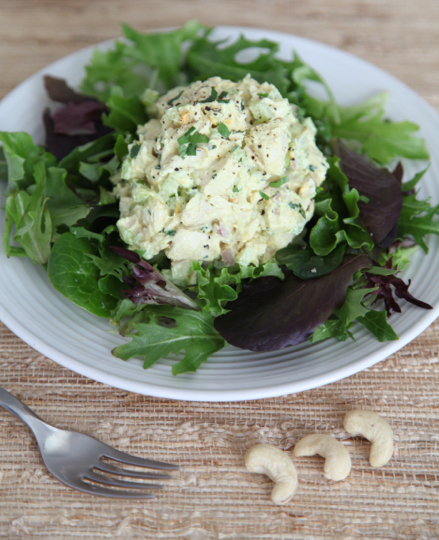 Cashew cream is a vegan obsession that can certainly have a place in a Primal kitchen. To make cashew cream, simply blend cashews nuts with water. A little bit of water makes thick, spreadable cream—and a lot of water turns cashew cream into cashew milk. Either way, the texture is smooth and creamy while the flavor is mild and slightly sweet.
Cashew cream is a vegan obsession that can certainly have a place in a Primal kitchen. To make cashew cream, simply blend cashews nuts with water. A little bit of water makes thick, spreadable cream—and a lot of water turns cashew cream into cashew milk. Either way, the texture is smooth and creamy while the flavor is mild and slightly sweet.
The natural sweetness makes cashew cream an instant dessert. Try a spoonful right out of the blender—it’s like nutty whipped cream. It’s good. A little too good. Don’t say you haven’t been warned.
Surprisingly, though, all it takes is a little salt, acidity, and spices to take cashew cream in a completely different direction. With those slight modifications, you’ll have yourself a savory dressing. Cashew cream is an obvious replacement for dairy, or, in this recipe, a stand-in for mayonnaise. Believe it or not, this mayonnaise-free chicken salad can easily compete against traditional chicken salad with mayo. The creamy, slightly tangy dressing coats the chicken nicely, and some celery and shallot add a little crunch.
Unlike traditional chicken salad, this recipe also adds fresh turmeric root for a hint of earthy flavor and powerful health benefits. (If you also want to add curry powder to make full-on curried chicken salad, go for it.) The great thing about fresh turmeric root is, well, its fresh flavor—as opposed to dried turmeric powder, which can be stale and muted. Fresh turmeric root is similar to ginger in appearance (except for turmeric’s bright orange color) and can be sliced, grated and used in similar ways. Turmeric root will stay fresh in the refrigerator for several weeks and can be added to foods like soups, stir-fries and your other favorite dressings and sauces.
Servings: 4
Time in the Kitchen: 15 minutes (plus at least 4 hours to soak the nuts)
Ingredients:
Cashew Cream
1 cup whole, raw, unsalted cashews (140 g)
1/2 cup water (120 ml)
Cashew Turmeric Chicken Salad
3 cups chopped, cooked chicken (450 g)
6 tablespoons cashew cream (90 ml)
2 teaspoons lemon juice (10 ml)
1 teaspoon apple cider vinegar (5 ml)
2 teaspoons coconut aminos (10 ml)
3/4 teaspoon Dijon mustard (4 ml)
1 tablespoon extra virgin olive oil (15 ml)
1 1-inch/2.5 cm piece of fresh turmeric root, peeled and grated (add more, to taste, if you like)
2 tablespoons finely chopped parsley (30 ml)
1/2 teaspoon salt (2.5 ml)
2 ribs celery, finely chopped
1 shallot, finely chopped
Cracked black pepper
Instructions:
Cashew cream
It’s hard to make tiny batches of cashew cream, so this recipe will make a little more than you need for the dressing. The amount of water added here makes a thick, but not stiff, cream. Add a little less water for a thicker cream or add 1 1/2 to 2 cups water (350 ml – 475 ml) to make cashew milk.
First, soak cashews at least 4 hours or overnight in cold water. Drain and rinse.
Put the cashews and 1/2 cup (120 ml) water in a high-powered blender. Blend for 1 to 2 minutes, scraping down the sides as needed, until the consistency is similar to whipped cream. The texture should be very creamy with no bits of nut left at all.
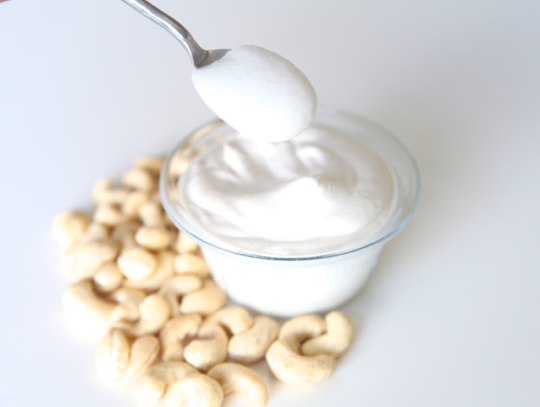
Cashew Turmeric Chicken Salad
Recipe Note: A microplane zester works well for grating fresh turmeric root. Fresh turmeric will stain anything it comes in contact with bright orange, so make sure to wash your grater and your hands immediately.
In a small bowl, whisk together 6 tablespoons (90 ml) of cashew cream, plus the lemon juice, apple cider vinegar, coconut aminos, Dijon, olive oil, turmeric root, parsley and salt.
In a large bowl, mix together the chicken, dressing, celery and shallot. Top the chicken salad with cracked black pepper.
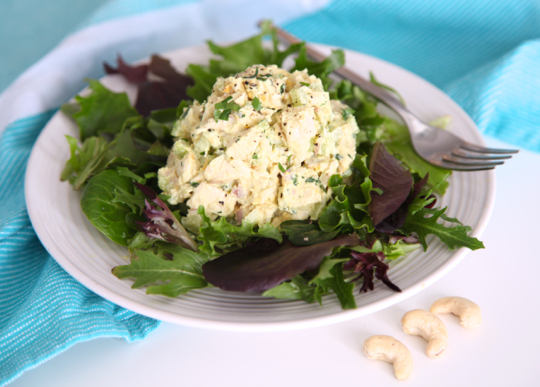
Now, for the Contest!
The Prize:
 3 Bottles of Greek Vinaigrette: Using real, organic oil of oregano, organic apple cider vinegar and the freshest ingredients (avocado oil, organic red wine vinegar, black pepper and lemon) our perfectly balanced vinaigrette is a tantalizing and refreshing complement to any salad. Its lush herb flavor is balanced with a hint of sweetness, savory spices and the zest of fragrant lemon oil—the quintessential addition to roasted chicken…or drizzle some on top of your vegetable lasagna. It also pairs very well with heavier fish like mackerel or sablefish.
3 Bottles of Greek Vinaigrette: Using real, organic oil of oregano, organic apple cider vinegar and the freshest ingredients (avocado oil, organic red wine vinegar, black pepper and lemon) our perfectly balanced vinaigrette is a tantalizing and refreshing complement to any salad. Its lush herb flavor is balanced with a hint of sweetness, savory spices and the zest of fragrant lemon oil—the quintessential addition to roasted chicken…or drizzle some on top of your vegetable lasagna. It also pairs very well with heavier fish like mackerel or sablefish.
3 Bottles of Honey Mustard Vinaigrette: This succulent dressing packs in the pungency of stone ground mustard and the sweetness of organic honey, perfectly enhanced by a tangy bold touch of lemon. It pairs well with slightly bitter greens, like chicory, Belgian endive, escarole or radicchio, and is succulent enough to be used as a dipping sauce for veggies…or to flavor your favorite fish, chicken or beef dishes. Honey mustard-flavored braised short ribs, anyone?
The Contest:
Last contest of the challenge with almost $50 worth of goods up for grabs! All you have to do is enter below by selecting one of the two entry options.
Contest Deadline:
January 24th, midnight PDT.
Choosing a Winner:
One entry from the above widget will be chosen at random.
Eligibility:
Anyone in the world can enter!
To track all the contests visit the 2016 Primal Blueprint 21-Day Challenge Contest Page for daily updates.




January 22, 2016
Going Primal Transforms a Family of Four
It’s Friday, everyone! And that means another Primal Blueprint Real Life Story from a Mark’s Daily Apple reader. If you have your own success story and would like to share it with me and the Mark’s Daily Apple community please contact me here. I’ll continue to publish these each Friday as long as they keep coming in. Thank you for reading!
 I am a 43-year-old man who was an intravenous meth user for 18 years, in prison three times, jail 18 times, and homeless. I was saved from my drug use and criminal life, but I had become depressed. I became reclusive and began to eat myself into obesity…topping the scales at 315 pounds. I had absolutely no energy and was completely useless to my wife and son. The example I was setting for my two-year-old son was an unhealthy lifestyle. Unless I changed my habits, and he continued to eat what I was serving him, his health would suffer.
I am a 43-year-old man who was an intravenous meth user for 18 years, in prison three times, jail 18 times, and homeless. I was saved from my drug use and criminal life, but I had become depressed. I became reclusive and began to eat myself into obesity…topping the scales at 315 pounds. I had absolutely no energy and was completely useless to my wife and son. The example I was setting for my two-year-old son was an unhealthy lifestyle. Unless I changed my habits, and he continued to eat what I was serving him, his health would suffer.
I was eating fast food, processed food, cereals, boxed foods, canned foods, juices, sodas, etc. Out of concern for my well being, my cousin, who has been living the paleo lifestyle for years, introduced me to Mark’s Daily Apple for more information and direction on eating paleo. What I read made sense, and I took it on 100%. I was amazed at not just the weight loss, but at the enormous increase in my energy. Over time my depression lifted.

Using nutritional information from Mark’s Daily Apple in combination with my workout routine, I was able to lose 140 pounds and gain lean muscle in 15 months. My energy level is remarkable. Bed at 8:30 p.m. and up at 3:30 a.m.I am a personal trainer for others, and I care for my two sons and my wife, so my days are always jam packed, and I never fatigue.
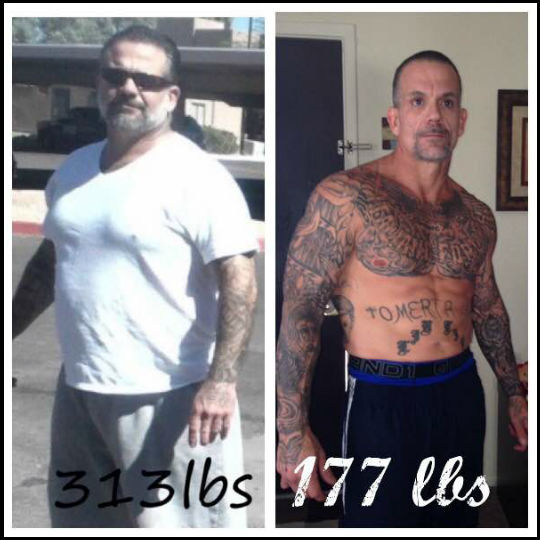
My 33-year-old wife is following the paleo diet guided by Mark’s Daily Apple, along with her workout routine, and has lost 170 pounds.
When I first began this lifestyle, my two year old son weighed 72 pounds and was at risk for diabetes, had respiratory problems and was obese for his height and age. He is now four years old, weighs 53 pounds (right on target for his height and weight), his blood results are all within normal range and his health is perfect. The pediatrician asked how he lost 20 pounds, because they never recommend for children to go on a diet. However, they were amazed that his blood work was perfect even with his weight loss. We talked to the pediatrician about the Paleo lifestyle and recommended Mark’s Daily Apple. They were absolutely amazed and said they had never seen this before.
It is a common belief that the Paleo lifestyle is too costly. However, we are a family of four and are currently living on the salary my wife makes as a waitress. To say we are poor is an understatement. Paleo is not a diet for us, it is a lifestyle and a mindset change. Sodas, burgers, chips, candy bars, Starbucks, packaged, canned food, etc., are costly! Now, what I am not spending on unhealthy food, I designate that same money to PALEO foods. It works out financially to be the same, but so much better for your life!
Mark’s Daily Apple was my go-to source from the start and that will never change. Mark’s Daily Apple has helped transform, inside and out, the man you see before you. With Mark’s Daily Apple I began feeling a difference immediately, seeing a difference within two weeks, and hearing from others the difference they were seeing in me within a month of changing my eating and exercising habits.
I would say good luck, but if you follow Mark’s Daily Apple, luck has nothing to do with the changes you will experience.
David




Contest: Win a Better Breakfast
The Prize:
 A $200 Breakfast (and more) package from U.S. Wellness, comprising the following: Beef Minute Steaks, Beef Breakfast Italian, Sausage Sliders, Beef Breakfast Polish, Sausage Sliders, Beef Pemmican, Honey/Cherry Free Bar, Beef Tallow – small pail, BEEF Sugar Free Bacon Slices, BEEF Sugar Free Bacon Tips, Sugar Free Canadian Pork Bacon Slices, Sugar Free Pork Bacon Slices, Beef Gelatin, Beef Snack Sticks, Beef Head Cheese, Beef Liverwurst, Beef Braunschweiger, Sugar Free Pork Sausage, and Bison Chorizo Sausage.
A $200 Breakfast (and more) package from U.S. Wellness, comprising the following: Beef Minute Steaks, Beef Breakfast Italian, Sausage Sliders, Beef Breakfast Polish, Sausage Sliders, Beef Pemmican, Honey/Cherry Free Bar, Beef Tallow – small pail, BEEF Sugar Free Bacon Slices, BEEF Sugar Free Bacon Tips, Sugar Free Canadian Pork Bacon Slices, Sugar Free Pork Bacon Slices, Beef Gelatin, Beef Snack Sticks, Beef Head Cheese, Beef Liverwurst, Beef Braunschweiger, Sugar Free Pork Sausage, and Bison Chorizo Sausage.
The Contest:
Today’s contest is so easy a caveman could…well, it’s super easy. Follow @USWellnessMeats and @MarksDailyApple on Instagram, then comment on the contest post here to let us know you’ve entered.
While there can only be one prize winner, you can still acquire some of your own top quality meats by visiting U.S. Wellness online. And don’t forget to check out U.S. Wellness on Facebook and YouTube. Grok on!
BONUS: Use code BROTH21 for 20% off all orders under 40 pounds in US Wellness’ Pre-made Broths & Gelatins category. Expires midnight CST on 1/31/2016.
Eligibility:
Only U.S. residents are eligible.
The Contest End Time:
Tonight! January 22 at 11:59 PM, PDT.
How the Winner Will Be Determined:
A winner will be chosen at random and emailed to arrange for delivery.
To track all the contests, visit the 2016 Primal Blueprint 21-Day Challenge Contest Page for daily updates.




January 21, 2016
Why Did We Evolve to Feel Compassion? (Plus a Contest)
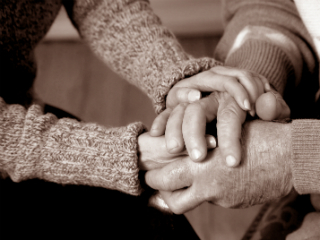 With the U.S. celebration of Martin Luther King Jr. Day, it felt like a good week to take up the question of compassion. In a week when we commemorate high human virtue (not to mention lend each other support during our biggest community endeavor of the year), what does it mean to offer compassion—and how did this inclination develop?
With the U.S. celebration of Martin Luther King Jr. Day, it felt like a good week to take up the question of compassion. In a week when we commemorate high human virtue (not to mention lend each other support during our biggest community endeavor of the year), what does it mean to offer compassion—and how did this inclination develop?
While compassion is defined a number of ways, the genuine crux of it is the concern we have for others’ struggles and suffering coupled with the desire to lend help or support in some regard. Rather than the “vicarious” emotional experience of another’s difficulties (sympathy or empathy, depending on who you talk to) or the actions we take in response to our concern for another’s situation (altruism), compassion records us more in the role of supportive witness—and perhaps motivated actor on another’s behalf. While today we consider compassion one of the most esteemed human traits, what were its origins? Is this really a product of evolutionary forces rather than cultural response? How could it have grown out of the rough and tough, survival-of-the-fittest world of Grok’s day?
The answer may be something of both nature and nurture, but make no mistake. The roots of compassion are pure genetic instinct even if modern society extends the context for compassionate exchange. Experts associate the development of compassion with a wide variety of key social dimensions within expanding human social organization. They note that compassion stands as its own emotion, differentiated from easily related feelings like sadness or even love.
Compassion can be both a trigger for and a response to our care-taking instincts—with obvious evolutionary benefits. When we feel concern for others’ well-being, particularly in the face of what we construe to be “undeserved suffering” or vulnerability, compassion moves us to display the emotional and behavioral responses of bonding, of claiming that person for our care, collaboration, kinship and/or protection.
It’s not hard to imagine the immediate genetic advantages. If Grok and his kin had a propensity for compassion toward their children and thereby were more attuned and responsive to the children’s needs and helplessness (particularly when they’re very young), those children would be more likely to survive. By extension, valuing compassion in one’s mate selection clearly would’ve been a key piece of this picture. Two compassionate parents would likely boost the child’s welfare.
While the primary evolutionary benefit might be that immediate offspring survival, group selection theory holds here, too. A tribe of reasonably compassionate individuals who were able to have concern and act for the benefit of others in the group would be better motivated and equipped to successfully collaborate, thereby supporting the survival of all. Evolutionary biologist, Robert Wright, calls this a second evolutionary logic, a product of later evolution (while kin selection, he suggests preceded even homo sapiens). This emotional evolutionary leap into extended kinship and its reciprocal altruism is that we’re motivated in that “you scratch my back, I’ll scratch yours” kind of way.
Wright explains, we are still working with a limited circle until we begin to embrace a still more theoretical social concept of non-zero sum gain–a relationship (situation) in which both you and I (or this group and that group) stand to gain something by collaborating. In the modern world, we more often find ourselves with knowledge or goods to share that will benefit both parties. National and international trade, communicable disease, and large-scale environmental concerns are all examples of interdependence or vaster scales of influence we’re smart to observe in our deliberations.
Yet, are we extending compassion a little too far here when we’re talking about the likes of international business? If we define compassion as an emotional instinct rather than a rational consideration, consciously self-serving intentions stretch beyond that scope of compassion. Wright, for his part, was talking more about society-scope collaboration than actual compassion, but it’s important to clarify the distinction for a number of reasons.
For one, rational deliberation won’t elicit physiological response, whereas primal emotion does. Beyond survival opportunity, is there a benefit to compassion? What, if anything does it have to do with health and well-being? More than you’d perhaps imagine….
Research shows practicing compassion trips the pleasure circuits in the caudate nucleus and anterior cingulate in the brain (triggering responses similar to those experienced when our own desires are fulfilled). In another study, compassionate actions enhanced self-esteem and self-reported happiness for several months following the initial actions. Acting from a place of compassion has also been shown to lower heart rate and raise oxytocin levels (that feel-good, social bonding hormone). Finally, research on compassion (or “loving-kindness”) meditation demonstrates enhanced immune response.
Of course, you can point out the irony in noting the self-serving elements of compassion and encouraging compassionate practice, but as the deeper dimensions of ancestral wellness consistently show, what works for the individual works for the group as a whole. In embracing the advantages to be had, you could say, we perform good self-care as well as Primal public service.
Thanks for reading, everyone. And check out the contest below for a fun way to share your own experience of compassion.
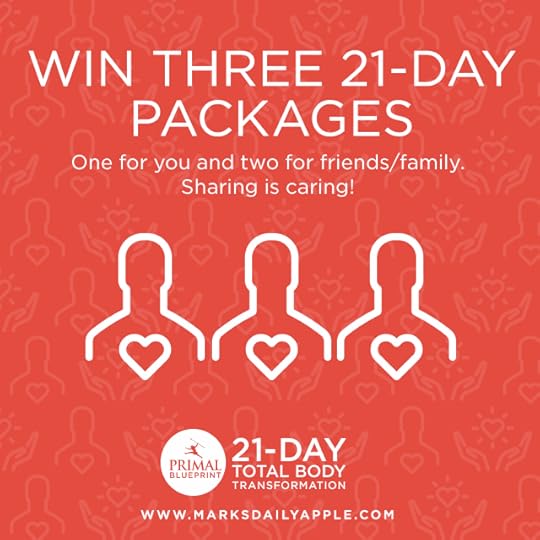 Contest
:
Contest
:
Can you think of one act of compassion you committed or witnessed during the last week? If one doesn’t come to mind, is there one you’d like to practice in the coming days? Share your answer below and I’ll give you the opportunity to share something special with family or friends. I’ll be giving away three 21-Day Total Body Transformation Essentials Packages to one lucky person who leaves a comment below. The winner will be chosen at random.
Deadline:
This contest expires today, Jan. 21, at 11:59 pm PST.
Like This Blog Post? Subscribe to the Mark's Daily Apple Newsletter and Get 10 eBooks and More Delivered to Your Inbox for FREE



January 20, 2016
How to Personalize Primal Blueprint Fitness
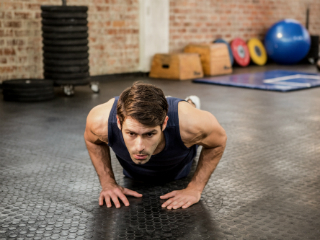 The Primal Blueprint 21-Day Challenge manifests differently for everyone. Some folks are focused on improving their diets, on removing this food or adding that food. Some have committed to optimizing their sleep by getting to bed at a certain time and eliminating nighttime electronics. And many just want to look better naked. But there’s one tie that binds nearly everyone I’ve interacted with through the course of this and previous challenges: physical activity. Whether you’re trying to eat, sleep, or look better, exercise matters. Effective exercise especially matters for everyone, and my intent when creating Primal Blueprint Fitness was to democratize fitness without compromising it—to distill effective training down to its essential elements so that everyone could practice it.
The Primal Blueprint 21-Day Challenge manifests differently for everyone. Some folks are focused on improving their diets, on removing this food or adding that food. Some have committed to optimizing their sleep by getting to bed at a certain time and eliminating nighttime electronics. And many just want to look better naked. But there’s one tie that binds nearly everyone I’ve interacted with through the course of this and previous challenges: physical activity. Whether you’re trying to eat, sleep, or look better, exercise matters. Effective exercise especially matters for everyone, and my intent when creating Primal Blueprint Fitness was to democratize fitness without compromising it—to distill effective training down to its essential elements so that everyone could practice it.
Sure enough, the same basic concepts apply to—and work for—everyone:
Strength train two or three times a week, focusing on the basic compound movements—pushing, pulling, squatting/knee flexion, hip extension, planking.
Sprint once a week—move as fast you can for short distances.
Get as much long, easy aerobic movement as possible—hiking, walking, easy trail running.
Play as often as you can.
Make your short, intense workouts—the sprints, the lifting—even shorter and more intense. Make your long, easy workouts—the walks, the hikes, the jogging—even longer and easier.
But here’s the thing about effort, intensity, workload, and even exercise choice: it’s all relative.
A former high school wrestler will apply the concepts differently than a 65 year-old retiree. A burnt-out CrossFitter will sprint, lift, and play differently than a disgruntled marathoner.
Elite athletes’ schedules will look very different. PBF probably won’t get you past BUD/S or into the upper echelon of the CrossFit games without serious modifications. Bodybuilders won’t be contest-ready on vanilla PBF. But for everyone else, this basic structure underlies every effective fitness program.
How can different populations tailor PBF to their needs, goals, and capacities? How does the retiree do PBF? The former CrossFitter? The recovering triathlete? The harried parent of twins? Let’s go through some basic archetypes and my recommendations for each.
The Retiree
Maybe you’re not exactly retired yet, but you’re certainly of the age, and you’re a little out of shape. You probably couldn’t identify a kettlebell. There’s a little, or big, paunch situated below your sternum. You’ve noticed everyday things getting a little bit harder than you’d prefer. Climbing more than two flights of stairs is unpleasant, your [enter body part] aches from time to time, and things that shouldn’t be sagging are sagging. You want to get stronger, be more active and comfortable on your feet, and lose some of that paunch.
Vanilla PBF is the way to go. Download the eBook if you haven’t already and stick to the basics. Figure out your capacities and work your way up from the bottom.
Pushups, squats, pullups, and planks. Assisted when necessary.
Sprints performed on a stationary bike. If you insist on running, sprint uphill, as that’s easier on the joints than sprinting on flat ground. Remember that sprinting is as fast as you can go, not as fast as others can.
Walk tons, hiking when possible. I don’t see the need to jog or run at all. You’ll only risk injury without getting any fitter than sprinting and lifting will make you.
Find something you love doing that keeps you active. There’s a reason you haven’t exercised much over the years, and not enjoying it is a likely candidate.
The Endurance Athlete
You’re skinny, or maybe skinny fat. You pride yourself on your capacity to run/bike/swim far longer than everyone else, but you’re unclear whether it’s actually improved your quality of life or overall fitness. You’d like to be stronger and—let’s face it—have bigger muscles. Even your lower body, which does the most work, isn’t nearly as impressive as your neighbor who doesn’t appear to do anything but lift weights a couple times a week. Not fair. Also, you’re skinny with an annoying layer of subcutaneous fat that won’t go away and, unbelievably, seems to get worse the more you run.
Limit yourself to one big training run a week. Your endurance capacity is high, so you have a weird idea of “easy, slow movement” and can get away with a lot more while keeping it easy. Whereas the average human finds a five mile run to be highly taxing, it’s chicken scratch to you. You need to tone it way down, if only to avoid getting sucked back into the maelstrom of hardcore chronic cardio.
Focus on strength. And once you have the bodyweight movements mastered—which shouldn’t take long, as you are an athlete—move on to weighted lifts. Lifting heavy things is most crucial for endurance athletes, as excessive endurance athletics done to the exclusion of all else tends to atrophy muscle and reduce bone mineral density. Lifting weights can reverse that trend and even improve your endurance performance by strengthening joints and giving you raw power. Get a coach if you need one. Just lift.
You also need to sprint. Since you’re a runner through and through, you can handle full-on sprinting. If you’re a cyclist, do 30 second all-out sprints with plenty of rest. You’re good at maximizing your output over long periods of time. Now it’s time to see how hard you can go for 10-30 seconds at a stretch.
Find something fun to do—a sport, a “childish” game like tag or capture the flag, anything. Speaking as a former marathoner, I know the love-hate relationship you have with your training. You hate doing it, you dread doing it, but love having done it. With physical play, you look forward to doing it, love doing it, and love having done it. Win-win-win.
The Parent
Bad sleep, worse eating habits. Stress levels sky high. Less sex than you’d like. More responsibilities than you’ve ever known. Parenting, especially the early years, can really throw your fitness routine for a loop. But you shouldn’t allow it. Training is more important than ever.
Strength training has to happen whenever you can grab it. You can’t rely on single chunks of time devoted to training. Working out while parenting is all about workout snacks. As soon as you wake up, do 10 squats and 5 pushups. While you’re waiting for the bottle heat up, do another 10 and 5. Plank while the kid’s nursing (unless your breast is involved).
When sprinting, keep it short and sweet. High stress environments call for low-stress training (stress is stress). And while longer sprints are supremely taxing, short (5-7 seconds) sprints are easy to recover from and still provide great benefit.
Walk every day as a family. Strap that kid onto your or your partner’s chest and walk. Walk through the neighborhood. Walk through green spaces (I strongly believe this is a way to lower stress for everyone and imprint the beauty and majesty and importance of nature onto your kid). Even if it’s just 15 minutes, walk.
Incorporate your kid. You can overhead press, KB swing, deadlift, squat, curl, row, and bench press a child throughout infancy and on into toddlerhood. Lay that slab of baby flesh across your back and do some pushups. Plop that kid astride shoulders and do walking lunges through the grocery store. You’ve probably got poop on your sleeve as you’re reading this, so why the modesty? Expel shame and embarrassment.
Play. Set a good example for the kid and stay sane.
The CrossFitter
CrossFitters who are happy with CF don’t go looking for other modalities. So if you’re considering switching to PBF, you’re probably a little burnt-out. That’s okay. That’s to be expected. CrossFit is a powerful tool melding fitness, community, and competition, but it’s very demanding. If you’re not careful and cognizant of your recovery, sleep, and nutrition, you might burn out.
Focus mostly on bodyweight exercises to lower the intensity from your normal routine or focus on heavy weights with low reps. Either way, you need to take a break from lifting moderately heavy weight for high volume at high speed with little rest. That’s the hallmark of many CrossFit WODs, and while it can get people really fit in a short amount of time, it comes at a heavy price.
Focus on all-out sprints with more rest than you think you need. Instead of running tabata hill sprints, take a full three to four minutes rest in between each one. Low rest intervals are great for building stamina, but I’ve noticed the greatest benefits from resting long enough to give it my absolute all each time. Rowing, cycling (your CF box probably has an Airdyne, which is fantastic for sprinting) also work.
Walk. Just walk. You’re gonna fight it. You’re gonna think you’re wasting your time. But trust me on this: you are healing your broken body and relearning how to simply move for movement’s sake. Don’t think about all the force you could be applying over time and distance and just move and glide through the world.
Pick up a sport. This is fun, so it’s a form of play, but team sports feed both your competitive streak and need for community that you may be missing. Also, the raw athleticism and stamina you’ve picked up CrossFitting will serve you well running up and down a field or basketball court.
The Office Worker
You sit all day. Your posture isn’t great. You may like your job, but you don’t like being cooped up inside all day. What to do?
Start with basic PBF. Just like the retiree (only younger), you’re probably out of shape and out of the game. You need to ease back in and get comfortable with the movements before increasing difficulty. The same recommendations apply to you. In addition:
Prioritize sleep. You’re working long days. You’ll be tempted to sacrifice sleep for training. Don’t.
Train outside as often as possible, maybe at lunch. You need the fresh air and the sun.
As you’ve noticed, there are many common recommendations. Pretty much everyone over the age of five needs to play way more than they do. Play doesn’t discriminate. I’d even argue that focusing on play becomes more important the older we get because the world conspires against us engaging in it.
And while I couldn’t speak to every individual situation, there are overlaps. People who come home from work exhausted from being on their feet or doing manual labor all day can refer to the CrossFitter recommendations. Anyone of any age who’s really out of shape can glean useful advice from the retiree and office worker sections.
That’s it for today, everyone. Read the post, see which section applies to you, and let me know what you think down below. Thanks for reading!
Prefer listening to reading? Get an audio recording of this blog post, and subscribe to the Primal Blueprint Podcast on iTunes for instant access to all past, present and future episodes here.
Like This Blog Post? Subscribe to the Mark's Daily Apple Newsletter and Get 10 eBooks and More Delivered to Your Inbox for FREE



Mark Sisson's Blog
- Mark Sisson's profile
- 199 followers


 thanks to my lovely photographer @deerdharma for taking this and laughing as I hop and squeal from the cold
thanks to my lovely photographer @deerdharma for taking this and laughing as I hop and squeal from the cold
